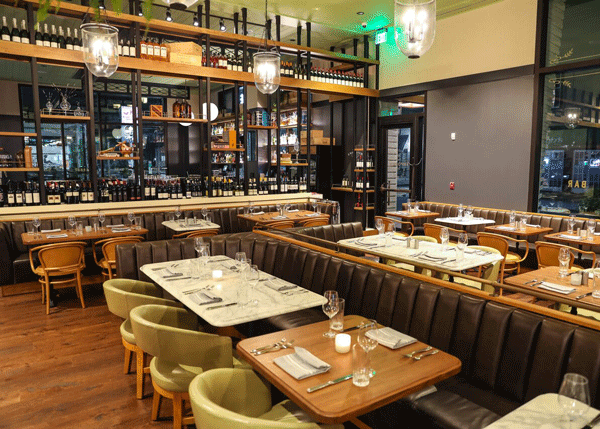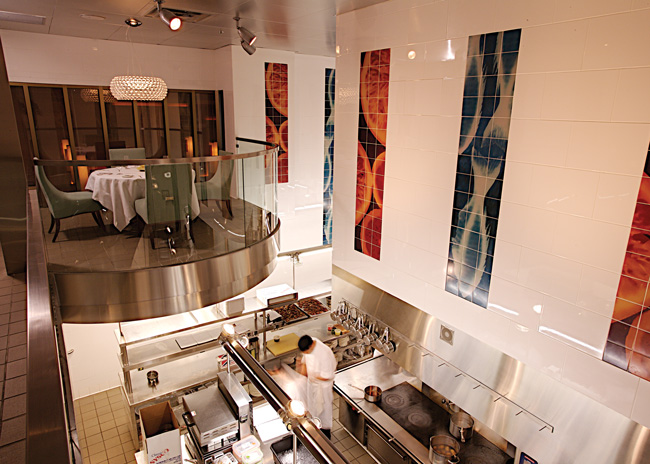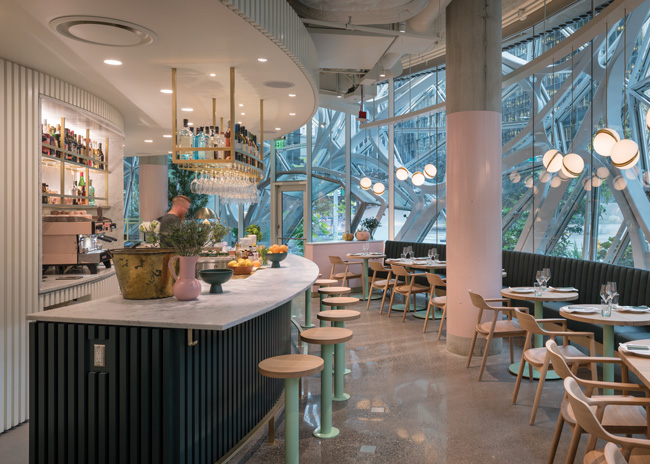Good food alone won’t turn a franchise into a roaring success. To succeed, an operation needs a solid franchisee support system and, of course, a design that compliments the overall concept. Founded in 2004, Pittsfield, Mass.-based Hot Harry’s Fresh Burritos is a fast-casual concept that proves the point. The chain has been franchising for several years, but has never had more than a handful of stores.
To help Hot Harry’s take the next step, in August 2015 the company hired a new president with a strong background in restaurant franchising, Richard Tarascio. One of his first tasks: develop a new prototype that would make Hot Harry’s a more compelling business proposition to potential franchisees. The first of these locations, owned by the company, opened last month in New Britain, Conn.
 Earth tones dominate the new Hot Harry's prototype.
Earth tones dominate the new Hot Harry's prototype.
While the previous store’s look was “not thought out,” says Tarascio, the new protoype has a cantina-inspired design, along with a franchisee-friendly price tag of under $300,000. “When you first walk in you’ll be like, ‘Wow is pretty cool. It has a comfortable feel but an earthy feel.”
The color palette of this new restaurant is built around earth tones, with walls painted in rust and muted yellow tones. For flooring in the dining area, Tarascio chose dark wood-style vinyl. Art, while still being selected, will add vibrant splashes of color to the space through photos of old cantinas, bundles of peppers and the like.
For seating, the new design got rid of booths. Now it relies on brushed aluminum chairs paired with two- and four-top tables with cherry wood butcher-block tops. This change, says Tarascio, helps reduce build-out costs, since booths are more expensive than tables and chairs. It also allows the stores to operate in smaller footprints. While the earlier Hot Harry’s locations took up as much as 2,500 square feet, this new prototype is only 1,800 square feet. Much of this reduction in space came by eliminating bulky booths, he says.
The chain also saved money with its new menu boards, going from digital displays to static boards that use velcro to hold menu offerings in place. While Hot Harry’s may reconsider digital boards as it gets bigger, for now static is the way to go, Tarascio says.
“Digital is great, but it’s costly. Most digitals are in franchises that are half a million, $750,000 and up, where cost is no object. We want something that the franchisee can change for $100, but still looks good. It’s easy to read, it's easy for the customer to enjoy.”
While cost was a primary concern in the redesign, it wasn’t the only consideration. To achieve a cantina look, Tarascio wanted elements that provided an earthy, lived-in feel.
One of these is the use of brick- and stone-style finishes.
 Brick facades add earthy colors and a rustic touch to the design.
Brick facades add earthy colors and a rustic touch to the design.
The wall behind the menu board, for example, has a brick facade, while the POS counter (sitting in front of the display kitchen) has a stacked stone finish that is both earthy and sophisticated. Rust-colored corrugated metal has been placed on the lower part of the wall along the dining area, which protects the walls from scuffing while also providing another earthy element.
The chain’s lighting design, which relies exclusively on LEDs, also helps Hot Harry’s achieve the cantina feel.
Above the POS counter, the chain stalled high-end pendant-style lights. These fixtures are reminiscent of copper, and feature blue-green rims that mimic a copper patina.
For the dining area, the chain uses round metallic pendant fixtures that look like large stew pots with handles. “It’s amazing how much feedback we get on those lights,” Tarascio says. “I just thought they were cool when I saw them. They’re extremely cheap, but they give that flair of this as a cantina-style place, where you’ve got the high-end stuff that looks high end as well as a mix of low-end stuff, and people are in love with it.”

This thought-out combination of high and low — both in style and price — gives Hot Harry’s a look that reinforces the overall concept while making it an attractive opportunity for potential franchisees, Tarascio says.
“We wanted to have an upscale look with the lighting and the corrugated metals and the floors, but keep it at a cost that is realistic for somebody to get into. $275,000 doesn’t sound like a lot, but for a lot of people, it’s their whole savings.”



